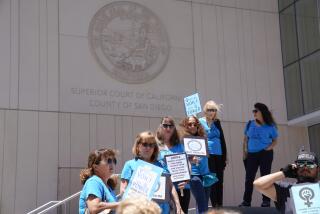Probation Officers Strain to Keep Up With Caseloads
- Share via
Michael Bennett joined the Los Angeles County Probation Department 10 years ago because he wanted to help troubled people. Now he has more troubled people than he can handle.
As a deputy probation officer, he must ensure that as many as 1,000 adult criminals pay restitution, attend drug treatment programs and meet other obligations imposed by the courts.
But with that kind of caseload, Bennett rarely has time to check up on his probationers at home. Instead, he usually holds quick meetings with them in between writing reports, taking calls from police and rushing to courtroom hearings and sentencing.
“There is never a slow period,” he said from his cramped cubicle in a converted department store in the Athens area near Inglewood.
Bennett is an example of the daunting problem facing probation officers in Los Angeles County: In the last 20 years, the number of adults on probation has nearly doubled to 77,000, yet the department responsible for supervising them is still staffed at 1978 levels.
Because of this, most criminals on probation are supervised at a ratio of one probation officer for every 1,022 criminals, one of the worst ratios in the state. To help cope with the huge numbers, the department allows many criminals to report to their probation officers by mail instead of in person--a practice strongly criticized by a recent county audit.
Law enforcement officials recommend a ratio of no more than 100 adult criminals per probation officer. But few counties in Southern California can meet that guideline. In Orange County, the ratio is as high as 480 to 1. In Ventura and Riverside counties, the ratio is as high as 1,000 to 1.
With such caseloads, experts say, criminals on probation can easily violate the conditions of their probation--even commit serious crimes--without being caught.
“You talk about falling through the cracks, these guys are busing through the cracks,” said Ralph Miller, president of the Deputy Probation Officers Union, Local 685.
Probation officers are among several public employee groups that struggle with huge caseloads despite swelling government budgets due to a robust economy.
Experts say the neediest and most troubled members of society are ignored or neglected because governments continue to allow public employees such as prosecutors, social workers and foster care investigators to work with overwhelming caseloads. For example, critics say a flawed system of oversight contributed to the deaths of two children who died earlier this year while wards of Los Angeles County’s foster care system.
For probation officers, the already high workload increased after Proposition 13, the 1978 ballot measure that froze property taxes and forced government to cut staff in many crucial agencies.
The department--which is responsible for nearly 100,000 adult and juveniles on probation--is staffed with 1,040 deputy probation officers. But nearly half of those officers are assigned to prepare reports on defendants who are to be sentenced in court.
Probation is a formal agreement that convicted criminals make with sentencing judges to reduce or avoid jail time. Probation officers, like Bennett, are responsible for ensuring that the criminals meet the obligations.
Meeting About 8 Probationers a Day
Bennett, 34, is a soft-spoken former college football player with an imposing build.
His caseload varies from 600 to 1,000 probationers. Despite those numbers, Bennett said he tries to meet with as many probationers as possible because there is no substitute for face-to-face meetings.
On a typical day, he sees about eight probationers in person. He questions most of them for about 15 minutes, asking them how they spend their time, whether they are working and staying out of trouble. About 15 probationers a day check in with Bennett by mail.
Last week, he met with Moses, a probationer with a long criminal history and a reputation as a bully in his South-Central neighborhood. Moses, whose last name was withheld by the department, was convicted of spousal abuse several years ago and arrested again last month for being armed with a gun.
Bennett warned Moses that he had violated his probation by being arrested and by failing to notify Bennett about the arrest.
“I’m asking you for forgiveness,” Moses said.
Bennett did not buy it. He said he had no choice but to report Moses to the court. A judge, he said, will decide if Moses will go to jail.
Bennett reminded Moses that he was also behind on his child support payments and restitution stemming from the spousal abuse conviction. Moses wrote a check for $40, saying that was all he could afford.
Again, Bennett was skeptical. After all, Moses was wearing a double-breasted suit, patent leather wingtips and a gleaming gold watch with a matching gold earing.
Bennett eyed Moses and sighed. “It is best that you get your life in order,” he said before escorting Moses out.
Moses is among about 46,000 probationers, or nearly 60% of all adult probationers, who are considered low risks and so are supervised at a ratio of 1,000 to 1. These probationers are usually first- or second-time offenders who have committed such crimes as petty theft and aggravated assault. They are allowed to report to their probation officers by mail.
The mail program was created in 1982 to help manage increasing caseloads. Probationers answer a series of questions about their work and home life on a form they mail in each month.
Probation officers have the authority to require these probationers to report in person from time to time.
Union President Miller calls the mail program a joke that makes it too easy for criminals to violate probation without getting caught.
“I have no faith in the system at all,” he said.
For example, Miller said, Larry Eugene Phillips Jr., one of the two gunmen responsible for the North Hollywood bank shootout in 1997, was in the mail probation program just prior to the shooting. Miller said the shooting might have been avoided if a probation officer had monitored Phillips more closely.
Some Don’t Report In for 2 Years
County Auditor-Controller Alan Saski is also critical of the program.
In an audit released last month, Saski said his office reviewed 80 probationers in the mail program and found that nearly 40% were not reporting on a monthly basis and 56% were not making their monthly restitution or child support payments. In a few cases, probationers did not report in for more than two years.
Those results strongly suggest “that probationers do not take seriously their responsibility to comply with their conditions of probation,” Saski said in the audit.
Hard-core criminals--those with a lengthy criminal record and a likelihood of breaking the law again--are supervised at a ratio of 200 probationers per officer and are required to report in person each month. (This is similar to the state-run parole for criminals released early from prison.)
Richard Shumsky, the county’s chief probation officer, does not dispute the county audit. He said he would prefer that all probationers meet in person with their probation officers, but that is impossible because of limited resources.
Probation officers say they work hard to monitor their probationers, despite overwhelming caseloads. They say they call probationers in for face-to-face meetings as often as possible, and contact employers and drug counselors to verify information on the mail-in forms.
Primous Howard Jr., a probation officer in the same office as Bennett, has a caseload of about 600 and said he would not be able to handle it all without the mail program and the clerical staff.
“It’s manageable but only because we have all of these tools,” he said.
Bennett said he finds his job satisfying despite the workload. Yet, he added with a smile: “I would love a slow period.”
(BEGIN TEXT OF INFOBOX / INFOGRAPHIC)
By the Numbers
Ratios of criminals to probation officers in Los Angeles County:
1,022 : 1 for “low risk” criminals
200 : 1 for hard-core criminals
150 : 1 for domestic violence offenders
70 : 1 for child predators
100 : 1 Maximum ratio recommended by law enforcement officials for all criminals
More to Read
Sign up for Essential California
The most important California stories and recommendations in your inbox every morning.
You may occasionally receive promotional content from the Los Angeles Times.











